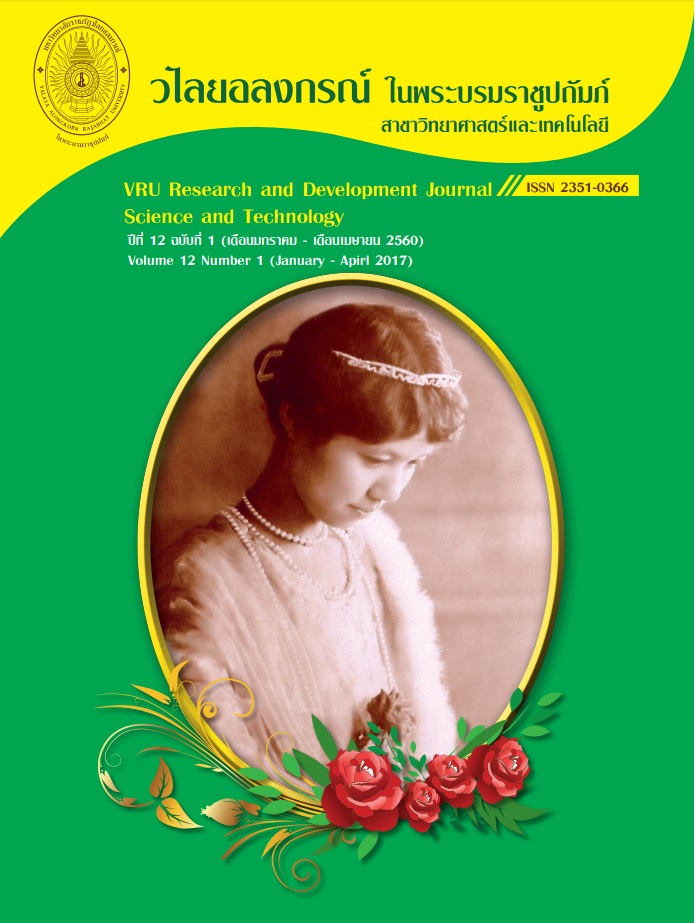ผลของรีคอมบิแนนท์ Trypsin-Modulating Oostatic Factor ต่อลูกน้ำยุงลาย
Main Article Content
Abstract
Trypsin Modulating Oostatic Factor (TMOF) เป็นเปปไทด์ฮอร์โมนขนาด 10 กรดอะมิโน ที่สามารถพัฒนาเป็นสารกำจัดลูกน้ำยุงลายได้ แต่ด้วยการผลิตเปปไทด์นี้มักใช้วิธีการสังเคราะห์ทางเคมีซึ่งส่งผลต่อต้นทุนการผลิตเชิงอุตสาหกรรม งานวิจัยนี้จึงศึกษาการผลิตเปปไทด์ TMOF ด้วยวิธีที่ง่ายและประหยัด โดยการสังเคราะห์โอลิโกนิวคลีโอไทด์ของยีนที่กำหนดเปปไทด์เป้าหมาย แทรกยีนที่สังเคราะห์เข้ากับเวคเตอร์ pET11a ถ่ายพลาสมิด pET11a/tmof เข้าสู่แบคทีเรีย Escherichia coli แล้วชักนำให้เกิดการแสดงออกของยีน tmof สกัดบริสุทธิ์เปปไทด์เป้าหมายด้วยเทคนิคคอลัมน์โครมาโตกราฟี และทดสอบฤทธิ์ต่อลูกน้ำยุงลาย (Aedes aegypti) จากการศึกษา พบว่า ยีนสังเคราะห์ tmof ไม่ก่อพิษต่อโฮสต์เซลล์ อีกทั้งยังได้เปปไทด์เป้าหมายในปริมาณมาก ถึงแม้ไม่สามารถสกัดบริสุทธิ์เปปไทด์เป้าหมายได้สำเร็จ แต่จากผลทดสอบฤทธิ์ทางชีวภาพโดยใช้แบคทีเรียโคลน (0.001-100 ppm) เพาะเลี้ยงลูกน้ำยุงลายระยะที่ 3-4 พบว่า สามารถยับยั้งการเติบโตของลูกน้ำยุงลายที่ทุกความเข้มข้น โดยแบคทีเรียโคลนช่วง 0.1-1 ppm มีผลต่อการเติบโตมากที่สุด สรุปได้ว่า การผลิตเปปไทด์ TMOF ในแบคทีเรียด้วยเทคนิครีคอมบิแนนท์เป็นกระบวนการที่ดี ให้ผลผลิตในปริมาณมากที่ออกฤทธิ์ยับยั้งการเติบโตของลูกน้ำยุงลาย
Trypsin Modulating Oostatic Factor (TMOF) is a decapeptide hormone possibly developed as a new mosquito larvicide. However, the backbone chemical synthesis of TMOF is expensive at industrial level. We, here, established the convenient and inexpensive method of the peptide production. Oligonucleotides of the gene of interest were synthesised and ligated to expression pET11a vectors. The pET11a/tmof plasmids were then transformed into the Escherichia coli, TOP10, followed by expression and purification of rTMOF. Biological effect on Aedes aegypti larvae was also observed. We found that the synthesised genes were non-toxic hence brought out the high expression level. The purified recombinant TMOF remained unrecovered. We, then, fed and raised 3rd- 4th instar larvae with the cloned bacteria (0.001-100 ppm). The larval growth was physically retarded at all bacterial concentrations. The high effective concentration range was 0.1-1 ppm. We conclude that production of recombinant TMOF in E. coli is a promising process delivering high quantity and high activity for larval growth inhibition.
Downloads
Article Details
Copyright Notice
The copyright of research articles published in the VRU Research and Development Journal Science and Technology Journal belongs to the Research and Development Institute, Valaya Alongkorn Rajabhat University under the Royal Patronage. Reproduction of the content, in whole or in part, is prohibited without prior written permission from the university.
Responsibility
The content published in the VRU Research and Development Journal Science and Technology Journal is the sole responsibility of the author(s). The journal does not assume responsibility for errors arising from the printing process.
References
เลาจนา เชาวนาดิสัย. (2544). จุลินทีย์กำจัดลูกน้ำยุงลาย: แบคทีเรีย, 20 ตุลาคม 2559. http://webdb.dmsc.moph.go.th/ifc_nih/a_nih_1_001c.asp?info_id=592.
Borovsky, D. (1988). Oostatic hormone inhibits biosynthesis of midgut proteolytic enzymes and egg development in mosquitoes. Arch Insect Biochem Physiol., 7, 187-210.
Borovsky, D. & Carlson, D. A. (1991). Novel compositions and process for inhibiting digestion in blood-sucking insects. US Patent number 5011909A. Retrieved October 20, 2012, from http://www.google.co.uk/patents/US5011909.
Borovsky, D. (2003). Trypsin-modulating oostatic factor: a potential new larvicide for mosquito control. J Exp Biol., 206, 3869-3875.
Borovsky, D., Rabindran, S., Dawson, W.O., Powell, C.A., Iannotti, D.A., Morris, T.J., Shabanowitz, J., Hunt, D.F., DeBondt, H.L. & DeLoof, A. (2006). Expression of Aedes trypsin-modulating oostatic factor on the virion of TMV: A potential larvicide. Proc Natl Acad Sci USA, 103, 18963-18968.
Carlson, D.A., Krueger, C.M., Hehman, G., Borovsky, D., Rossi, A. M., Cockburn, A. F., Shabanowitz, J., and Hunt, D.F. (1994). Cloning and partial sequencing of the trypsin modulating oostatic factor (TMOF) gene from mosquito genomic libraries, and expression of the TMOF gene in Escherichia coli. In: Davey, K. G., Peter, R. E. and Tobe, S. S. (Eds.) Perspectives in Comparative Endocrinology (pp. 620-638). Ottawa: National Research Council of Canada.
Demain, A. L. & Vaishnav, P. (2009). Production of recombinant proteins by microbes and higher organisms. Biotechnol Adv., 27(3), 297-306.
Rosano, G. L. & Ceccarelli E. A. (2014). Recombinant protein expression in Escherichia coli: advances and challenges. Retrieved Mar 05, 2017, https://www.ncbi.nlm.nih.gov/pmc/articles/PMC4029002/pdf/fmicb-05-00172.pdf.
Saiful, A. N., Lau, M. S., Sulaiman, S. Hidayatulfathi, O. (2012). Residual effects of TMOF-Bti formulations against 1st instar Aedes aegypti Linnaeus larvae outside laboratory. Asian Pac J Trop Biomed., 2(4), 315–319.
World Health Organization. (2005). Guidelines for laboratory and field testing of mosquito larvicides. Retrieved April 25, 2012, http://apps.who.int/iris/bitstream/10665/69101/1/
WHO_CDS_WHOPES_GCDPP_2005.13.pdf.


